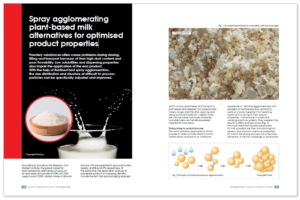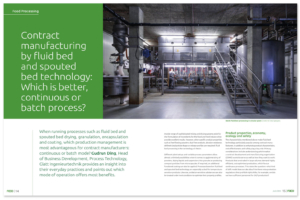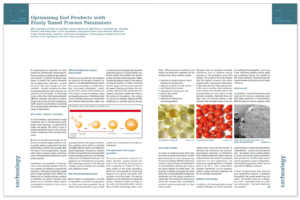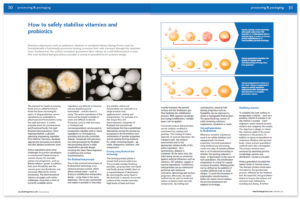Shaken or Stirred – Agglomeration with fluidized bed technology
Whether it’s infant formula, soups or shakes, instant foods are inseparably linked to many areas of life. If powdery substances are to be dissolved or dispersed in hot or cold liquids, then agglomeration is a vital quality improvement process, with fluidized bed technology providing the widest range of optimization possibilities.
High dust content, inadequate bulk density, lack of abrasion resistance or an undesirable color are just some of the challenges manufacturers face when working with dry materials. Coffee, cocoa or instant mashed potatoes, for example, are not only expected to be storage-stable, free-flowing and easy to dose, they should also disperse, dissolve or swell in a lump- and residue-free way. For the optimization of instant properties, fluid bed technology is a proven, highly adaptable and established technology. The experimental development of critical parameters is essential and should be tested in laboratory and pilot-scale plants to get flawless instant quality products ready for market. It should be noted, however, that production parameters cannot be calculated by simply scaling-up experimental data. Master batches provide evidence that the lab-scale can be transferred to a batch-based or continuous production-size process.
- Author: Melanie Guttzeit, Process Engineer, Glatt Ingenieurtechnik GmbH
- originally published in the trade magazine Asia Food Journal’, September-October/2016 issue, Contineo Media Pte Ltd.
High dust content, inadequate bulk density, lack of abrasion resistance or an undesirable color are just some of the challenges manufacturers face when working with dry materials. Coffee, cocoa or instant mashed potatoes, for example, are not only expected to be storage-stable, free-flowing and easy to dose, they should also disperse, dissolve or swell in a lump- and residue-free way. Quick to prepare, tasty and the right mouthfeel, not to mention price, are all decisive factors in the market success of instant products, which consumers take for granted.
Grain to grain
The principle of agglomeration, also known as build-up agglomeration, is based on the formation of solid bridges that connect loose particles together and allow the grain-on-grain growth of larger, loosely structured particles. Powdered particles are first wetted using a liquid, steam or both, and the bridges, formed by a chemical bond, crystallize and harden during the drying process. Naturally occurring electrostatic and van der Waals forces also play an important role. Liquid starting materials may be agglomerated by spray drying with a subsequent rehydration process, depending on the application and raw material.
Wettability affects solubility
How quickly an instant product dissolves on shaking or stirring depends primarily on its wettability. Owing to the capillary pressure in beverage granules, the wetting liquids are rather abruptly — and unevenly — absorbed into the particles. Particle size is a key criterion: if the particles are too small, the liquid doesn’t fully penetrate and the powder sediments out; if the particles are too large, they are slow to moisten, which results in gas inclusions letting residue float on the surface. The viscosity of the liquid also plays a determining factor. For example, legal herbal additives in instant products can actually affect the viscosity in a positive way. Whatever the end product, though, all requirements and product features can be optimized and produced using fluidized bed technology.
Agglomerates build in the fluidized bed
When it comes to the agglomeration, spray granulation, coating or drying of ingredients for food, feed or fine chemical applications, fluid bed technology combines several processes in a single step. A typical system consists of the inlet air chamber, the process chamber, the spray device and the filter system.
By keeping the product quantity in suspension with an upward flow of warm air, the process air controls both the heat and mass transport. While the particles mix, they collide with each other. As such, volume flow and gas velocity are adjusted to prevent particle abrasion. Fine particles are returned using a pressure-based cleansing process from the internal blow back filters into the process chamber for further agglomeration.
Once the point of minimum fluidization has been exceeded and a uniform and homogenous fluidization behavior has been established, a liquid/suspension spray is introduced. The solvent is subsequently evaporated using a stream of hot air.
The ongoing collision, contact and addition of liquid droplets, along with cohesion forces and surface tension, produces loose agglomerates. The process continues until the desired particle size is reached. The resulting coarse granules have improved characteristics: they are more free-flowing and less electrostatic and the porous, capillary like structure is more wettable and dissolves faster.
Powdered milk applications
In addition to moistening, the dispersibility of instant products is of vital importance. To make sure whole milk powders have the right properties, lecithin is often used as a dispersion aid. Modified starch, pectin, alginates or carrageenan are used as stabilizers to make sure milk powder products only release their properties after moisture penetration. Bulk density also plays an important role.
As the following Glatt Ingenieurtechnik (Weimar, Germany) case study shows, the ideal combination of atomizing pressure, air velocity and filling height in the process chamber ensures the reproducibility of desired product properties. Wishing to investigate which parameters effect an increase in bulk density without compromising solubility, the end product target was a milk powder with a fat content of 26 percent that had a low particle size distribution and a residual moisture content of less than 3 percent. The average diameter of the particles was 900 microns. With regard to the bulk density, two filling sizes were desired: 250 g/L and 500 g/L.
Initial experimentation involved a laboratory scale fluidized bed plant to establish the parameters required for scale-up. The atomizing pressure must be determined empirically using a master batch. For this purpose, a batch size of 5 kg of raw material was converted to a production-scale size of 300 kg. After the appropriate parameters were determined for both the atomizing pressure and air quantity and found to be reproducible at production scale, the investigation continued. The required increase in bulk density can be achieved by introducing a higher quantity of product. This generates a larger bed height in the process chamber and helps to produce denser agglomerates.
Injection determines hardness, density and weight
Injection-related variables can significantly affect product properties such as agglomerate hardness, density and bulk density. The bottom-spray method with upwardly directed spray nozzles can lead to suboptimal hit rates, depending on the spray pressure, because the powder particles are not wetted enough. This leads to a lower particle size and a higher quantity of fine dust as also known to spray-drying. Therefore, the top-spray process with downward spraying nozzles on top of the fluidized bed is the most commonly used agglomeration process. The excess moisture associated with the countercurrent process produces agglomerates with a larger grain structure.
Fluid bed solutions for food applications
Whether water alone is a suitable spray liquid depends on the desired agglomeration properties. If the binding forces are inadequate, a food-approved binder is required. When choosing the right additive (polysaccharides or gelatin, for example), it is crucial that it interacts with the powder and forms a stable bond. This then contributes to higher viscosities and agglomerates that are stable at room temperature.
Instant products benefit from the use of high viscosity spray solutions to achieve larger agglomerate structures, which leads to better dispersibility. The higher the binder concentration, the stronger the liquid bridge binding forces and the larger the agglomerates.
Conclusion
For the optimization of instant properties, fluid bed technology is a proven, highly adaptable and established technology. The experimental development of critical parameters is essential and should be tested in laboratory and pilot-scale plants to get flawless instant quality products ready for market. Laboratory units such as Glatt’s “ProCell LabSystem” are available for hire for internal experiments. It should be noted, however, that production parameters cannot be calculated by simply scaling-up experimental data. Master batches provide evidence that the lab-scale can be transferred to a batch-based or continuous production-size process.
Specific enhancement of product properties
Fluid bed technology helps to optimize functional ingredients and combines several processes in a single step:
- Instantization of powders with optimal instant behavior
- Adjustable particle size
- Enhanced flow properties, good dosing
- Prevents segregation of powder mixtures
- Eliminates dust formation
- Easier tableting
- Low bulk density
- Dust-free round pellets with homogenous structure
- Good solubility and dispersibility
- High hardness and resistance to abrasion
- Narrow range of adjustable particle sizes
- High particle and bulk density
- Optimal protection for active substances against moisture, acids, oxidation etc.
- Functionalizes particle surfaces
- Targeted control of release behavior, such as odor or taste
- Increased storage compatibility and thermostability
- Different layer thickness for surface design
- Compact granules with extended shelf-life
- Stabilization of volatile and valuable substances
- Various carrier systems for optimized functionality
- Targeted variation of base materials for adjusted particle structures
Further information on this topic and related topics can also be found in the following publications:
Published article: ‘Spray agglomerating plant-based milk alternatives for optimised product properties’ PDF, English
Published article: ‘Contract manufacturing by fluid bed and spouted bed technology: Which is better, continuous or batch process?’ PDF, English
Published article: ‘Optimizing end products with finely tuned process parameters’ PDF, English
Published article: ‘Hot-melt applications for the food and beverage industry – How to safely stabilize vitamins and probiotics’ PDF, English
Published article: ‘Customised enzymes for optimal animal feed mixes’ PDF, English







 Copyright: Deutscher Fachverlag GmbH
Copyright: Deutscher Fachverlag GmbH Copyright: publish-industry Verlag GmbH
Copyright: publish-industry Verlag GmbH